"Untitled" (2016)
Drawn with ink and pencil. This sketch was intended to show the artist's style of interconnected shapes with a human face. Curves, sharp angles, and continuous lines dominate this piece. Thicker shapes mark the lips, brows, and eyes. The eyes themselves are intended to unsettle the viewer with their empty gaze. Pencil was used to fill in the lower lip, eyes, and outline the flower in the hair.
More from this Category:

"Flute Choir: Winter Concert" (2021)
Created using Adobe Illustrator. Brochure cover designed to incorporate each piece from the repertoire. Since one piece featured a looming mountain, a mountain with a cascade of music notes in a staff contains the rest of the illustrations. Since "Defying Gravity" was being performed, 9.8 m/s^2 (acceleration due to gravity) was crossed out beneath the witch's hat from the Broadway musical, "Wicked." Since Tchaikovsky's "Nutcracker Suite" was being performed, a nutcracker soldier is kept in the boat. Three snowflakes, drawn in the Celtic knot style, represent the "Celtic Folk Songs" piece. Since "I See the Light" from Disney's "Tangled" movie was part of the setlist, the sweeping riverboat from the lantern scene is kept at the base of the design. Showcase details are boxed to grab the onlooker's attention, and an original, hand-drawn font was created to accompany the festive, candlelight theme of a holiday concert. The rich maroon and white color scheme is meant to be bold and eye-catching from afar.

"Self-Portrait in St. Petersburg" (2015)
Freehand pencil sketch using 4B and HB pencils. Drawn on a train from Moscow to St. Petersburg, with focus on blocks of unblended shadows and looser, flowing shapes. The goal was to blend realistic and surrealistic styles between face and hair. The linework outlining the profile purposefully thins and thickens to create delicacy.
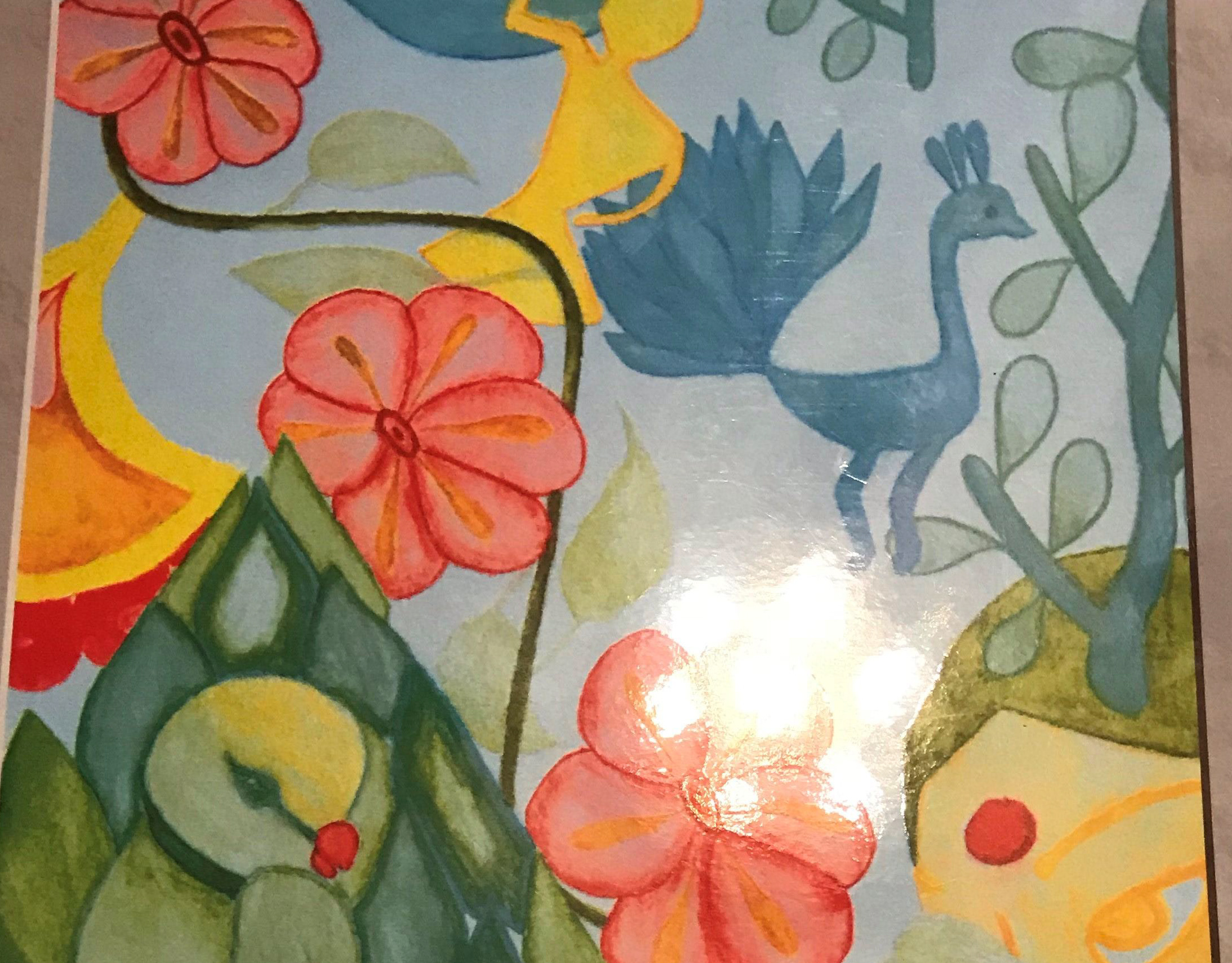
"Sita, Peacock, Parrot" (2013)
Watercolor pencil painting which incorporates elements from folk-art styles across India. Accepted for display at Sochi Winter Olympics exhibition in Citibank's office in Moscow, Russia. Included in printed booklet displaying artwork made by students at the Anglo-American School of Moscow. PIECE INFO: *Upper-right corner* contains peacock, dancer, trees in Warli style from west Indian state of Maharashtra. *Diagonal floral border* inspired by borders in Mughal paintings of Sita's kidnapping in the epic, "Ramayana." These paintings were commissioned by India's Mughal emperors and hence, Islamic styles of art, which highlight nature and geometry, became part of the epic's portrayal. *Left side* features leaves and a parrot. *Right side* is a woman wearing a bottu/bindi (mark of spiritual third eye) in the Bengali style. *At the bottom* is a chakra (discus/wheel), representing an Ashoka Chakra (symbol of Indian unity, featured on India's flag, named for Emperor Ashoka). Chakra also symbolizes cycles which guide Indian philosophies, such as Samsaara (cycle of reincarnation) in Hinduism and the Eight-Fold Path in Buddhism. Finally, the chakra is an ancient weapon used by gods in Hindu mythology.

"Indo-Chinese Classical Dance: Draft" (2024)
Drawn with ink. Each dancer is based on reference photographs of traditional Chinese classical dance costumes and traditional Indian classical dance/music costumes (Bharatanatyam, Odissi, Carnatic). Motifs associated with each culture, including a parasol and a sitar, are included. Each figure's costume, makeup, hairstyle, and accessories is distinct. Figures are arranged and layered on the poster to show people sharing classical arts and cultural spaces with each other. Motifs of the moon and the stages of love, which was the showcase theme, is included to the bottom left (moon phases) and bottom right (small hearts). Symmetry and balance was achieved by keeping figures in parallel poses and parallel colors. Finally, the cursive script used for the description stands in contrast with the showcase information, title, and the dance clubs' names (Mei-Kala). A bold, curved script was used to match the curves and angles of the performers' bodies. See "Indo-Chinese Classical Dance" (2024) to see final version of this poster.
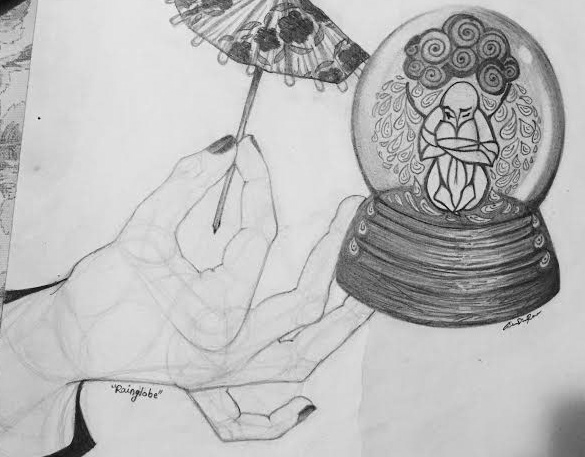
"Rainglobe: Trapped Angel" (2016)
Illustrated with pencil for a Drawing class assignment, in which students were instructed to create a piece that incorporated a hand, an object, and glass. Thus, this illustration is of a small, isolated, angelic figure trapped in a globe. A raincloud in the globe showers onto them, and the feathery drops turn into wings. Hence, the title of the piece. Meanwhile, outsiders attempt to offer comfort, represented by a hand holding a cocktail umbrella up to the glass. However, their efforts are futile; the figure is beyond their reach, and it will take more than a frail umbrella to shatter the glass. The figure, drafted in the second image below (you'll see it when you scroll down), has wrapped their limbs into a near-fetal position. They peek out at the hand, at the comfort being offered, but do not engage with it. Note the use of shading in the glass and wooden base of the globe, the high contrast of the figure's outline, a spot of light upon the glass, and the mechanical drawing style of the hand which breaks it into its simplest forms.
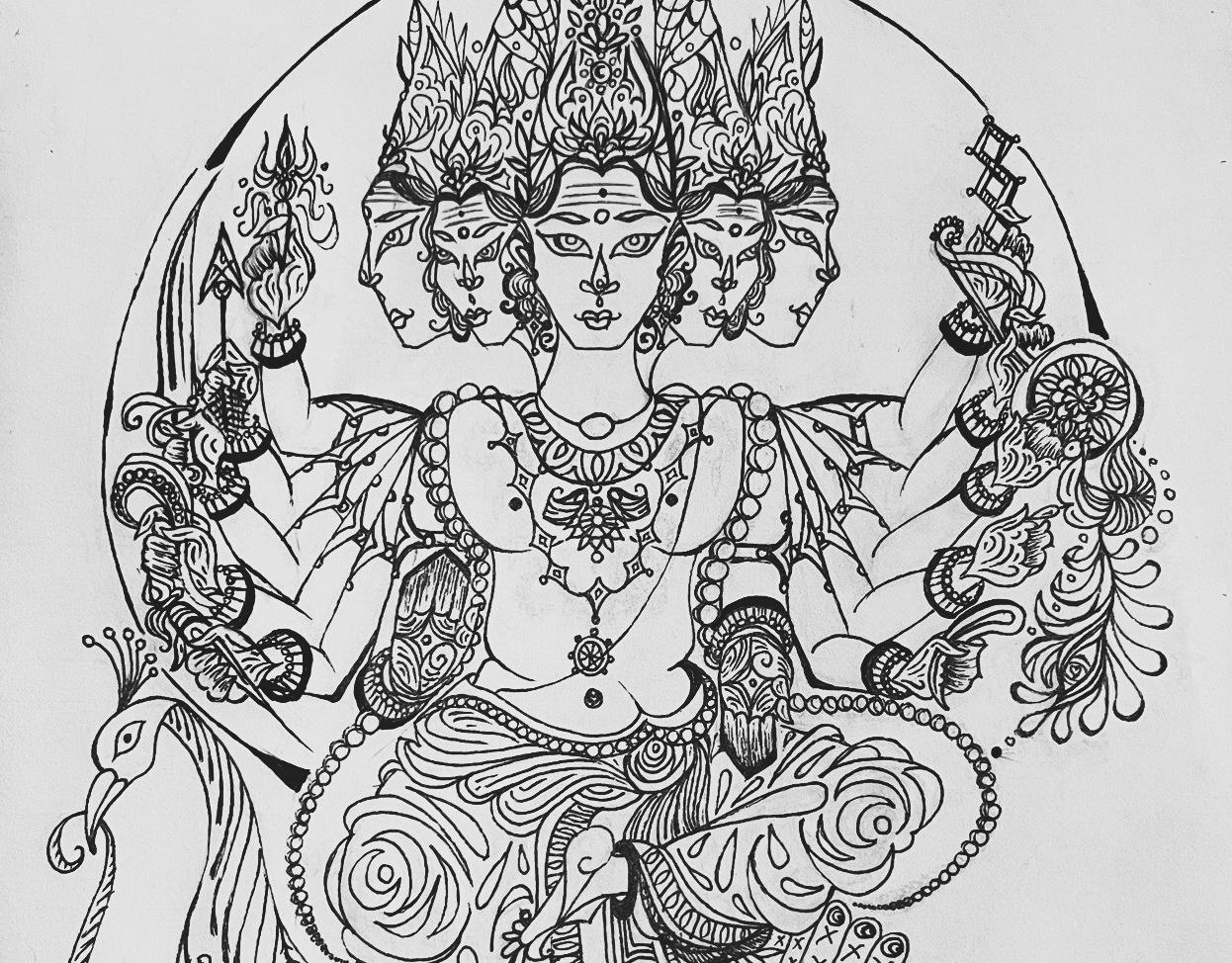
"War God: Karthikeya" (2024)
Drawn with ink. This piece depicts the five-headed, ten-armed form of Karthikeya, the Hindu god of war. His vehicle is a peacock which bites a snake, representing the triumph of good over evil. He carries different weapons in his hands, including: a sword, a trident, an arrow, a bow, a shield, and a noose. In his third arm on the right, he carries a rooster, which is his symbol. Each of his foreheads is marked with the symbol of his father, Shiva, and each of his heads are tilted in a different direction. A halo glow fits around in body in a circle. His chest is adorned with jewelry and his pants are drawn stylistically to show their draping. His first and second hands are facing forward to bless the onlooker. This piece is inspired by Raja Ravi Varma, the Indian painter who often chose mythological figures as his subjects. There is intense detailing in the crown and in the hands, as well as the attention to maintaining general symmetry in the arms and heads. The style of the peacock is inspired by Russian Orthodox icons. Note: the number of heads and arms is symbolic for deities in Hinduism, and the artist wanted to challenge herself with this piece, hence the outcome!
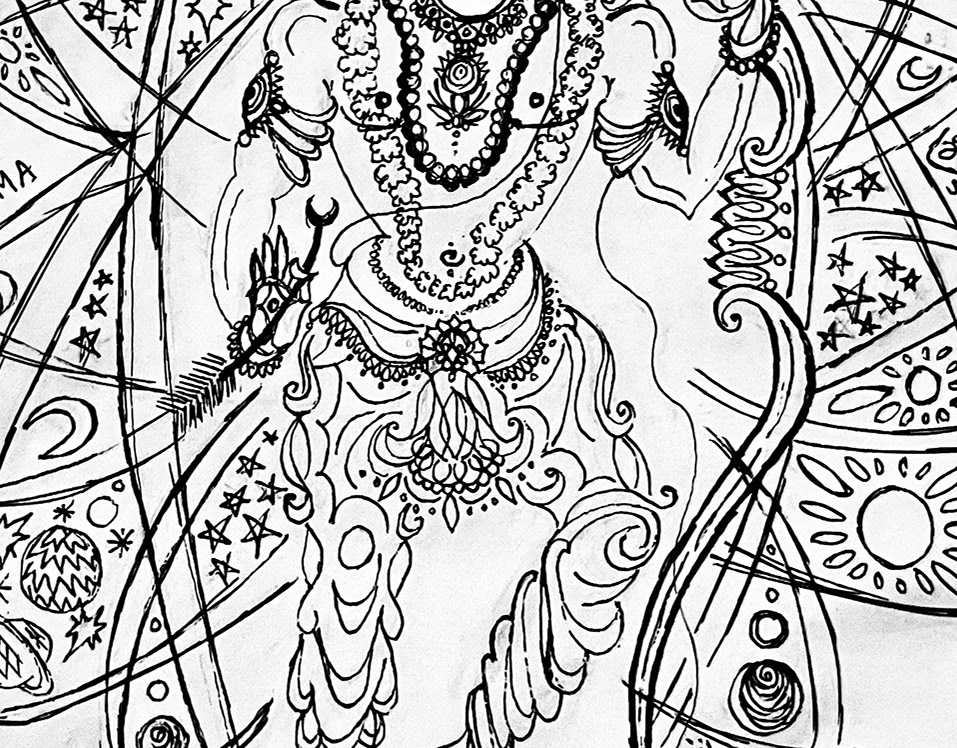
"Universe, Balance: Rama" (2023)
Created with ink, draft (scroll down) created with pencil. This illustration depeicts the Hindu god Sri Rama as the center of the universe, providing balance between opposing sides. He carries an arrow (with a crescent-shaped head, similar to that of ancient Indian arrows, which had different shapes) and bow whose string curls around his arms. His crown, belt, and jewelry indicate his status as a warrior king, and a sun-like halo surrounds his head. His forehead is covered in the symbol of the god Vishnu, whom he is the incarnation of. His pants are drawn stylistically to show draped silk. His feet have small sparks next to them. He is surrounded by a structure which contains suns and moons, planets and stars. Rama's name, in English, Telugu, and Hindi, is written amongst these parts of the universe. The structure symbolizes both the universe and an atom: to suggest that Rama is present in the largest scale and smallest scale. In this illustration, centering him within the smallest particle is a reference to Telugu poet Annamacharya's writing on the same subject. Finally, the sacred syllable "Om" outlines the structure. Note: This piece was intended to be the first in a series of illustrations for a devotional kirtan (song) about Rama, written by the late Dr. Advikolanu Muralidhar. So, this imagery reflects the lyrics. This style of art is inspired by the Vedic Art style, hence the curved body of the male figure, the oval-shaped face, and elaborate ornaments.

Executive Summary pg. 2 (2024)
Page 2 of Executive Summary targeted towards potential investors for Bloqcube Inc, a pharma-tech start-up. Designed using Adobe Illustrator. Highlighted company milestones, contrasted testimonials, and drew attention to competitive advantage graphic.

"Tamilian Grandmother" (2014)
Freehand ink sketch of a South Indian Tamilian grandmother with two nose stud piercings. The style of her bottu/bindi is also associated with Tamil culture. For the sake of the sketch and in a break from the typical bottu/bindi, this design is repeated along the bridge of the nose. The eyes are slender and wing-shaped; the tinge of blue in them represents the onset of old age in a dark eyes. The hair is shown to be white and black, and bursting flowers are tucked behind both of the grandmother's ears. Her necklace is shown in the upper-right of the sketch. A hint of colored pencil was used to color the blue-green in her eyes and in her face. The lips are curved to indicate a hidden smile. This style is influenced by Bapu, a South Indian Telugu artist.
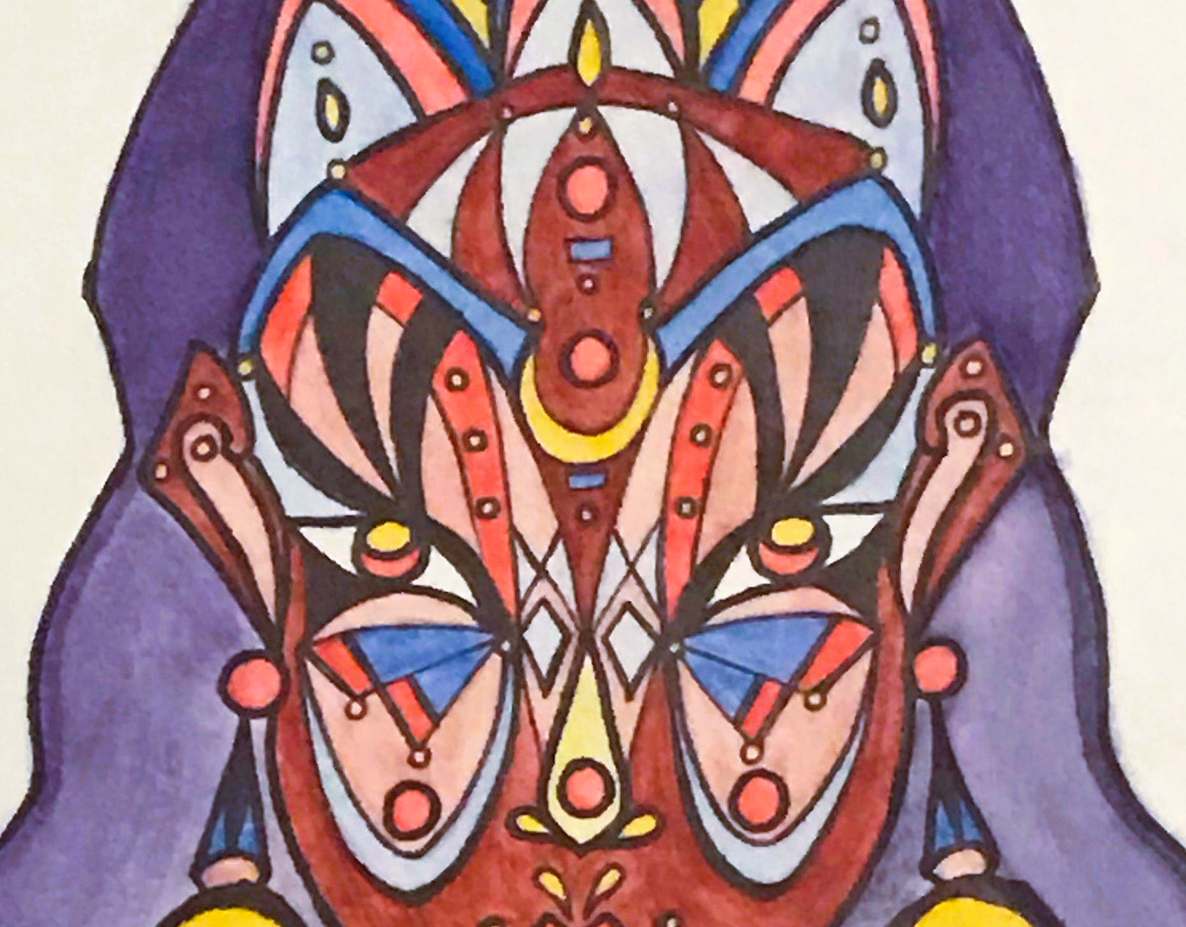
"Crescent Woman" (2014)
Watercolor pencil and ink painting of a woman, inspired by traditional African masks and South Indian Tamil style bottus (spiritual third eyes and marks of which Hindu deity one worships). This features the artist's love for finding and bringing out symmetry with geometric shapes in human faces, namely focusing on crescent, circular, and triangular shapes. Style is also influenced by Bapu, a South Indian Telugu artist who worked with bold colors and continuous lines.